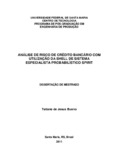| dc.creator | Bueno, Tatiane de Jesus | |
| dc.date.accessioned | 2012-03-09 | |
| dc.date.available | 2012-03-09 | |
| dc.date.issued | 2011-08-18 | |
| dc.identifier.citation | BUENO, Tatiane de Jesus. Analysis of bank credit risk with use of shell of probabilistic expert system Spirit. 2011. 90 f. Dissertação (Mestrado em Engenharia de Produção) - Universidade Federal de Santa Maria, Santa Maria, 2011. | por |
| dc.identifier.uri | http://repositorio.ufsm.br/handle/1/8201 | |
| dc.description.abstract | The goal of this dissertation is to organize a probabilistic expert system with use of
the Shell Spirit in order to evaluate the default risk of borrowers in a financial
institution or minimize the risk that it represents. The study was limited to private
individuals, since the variables used to analyse the risk in the concession of credit to
legal entities are different, and also to the fact that this area is less explored by
academics. The applied methodology was inserted in the context of a quantitative
empirical research, which aimed to bring the model developed as close to reality as
possible. However, in this step it was necessary to collect inside information of the
institution used to study, referring to risk analysis, credit policies, profile of borrowers,
and also to extract knowledge from the experts with the purpose of selecting the
relevant variables for the system and to make the interaction of these when
composing rules along with the definition of their weights. Consecutive to the
conclusion of the model, tests occurred with some favorable situations and/or
unfavorable to the granting of credit, considering that in this phase were instantiated
the pertinent variables to each situation at hand. The main idea of the system is to
manage and reduce the credit risk of bank institutions, for SPIRIT, an expert system
is able to work with uncertainties and manipulates data, being fed with information
that indicates the no default probability. The results obtained with the tests were
satisfactory as they were able to identify the probability of a borrower turn out to be a
no default or minimize the risk, even before the credit was released. | eng |
| dc.format | application/pdf | por |
| dc.language | por | por |
| dc.publisher | Universidade Federal de Santa Maria | por |
| dc.rights | Acesso Aberto | por |
| dc.subject | Risco de crédito | por |
| dc.subject | Sistema especialista | por |
| dc.subject | Pessoas físicas | por |
| dc.subject | Credit risk | eng |
| dc.subject | Expert system | eng |
| dc.subject | Private individuals | eng |
| dc.title | Análise de risco de crédito bancário com utilização da shell de sistema especialista probabilístico Spirit | por |
| dc.title.alternative | Analysis of bank credit risk with use of shell of
probabilistic expert system Spirit | eng |
| dc.type | Dissertação | por |
| dc.description.resumo | O objetivo desta dissertação é estruturar um sistema especialista
probabilístico com utilização da Shell Spirit para avaliar o risco de inadimplência de
tomadores de crédito em uma instituição financeira ou de reduzir o risco que ele
representa. O estudo foi limitado a pessoas físicas, uma vez que, as variáveis
utilizadas para a análise de risco na concessão de créditos se diferem das pessoas
jurídicas e, também, pelo fato de esta ser uma área menos explorada pelos
acadêmicos. A metodologia aplicada foi inserida no contexto de uma pesquisa
empírica quantitativa, na qual se buscou aproximar o máximo possível o modelo
elaborado à realidade. Contudo, nesta etapa foi necessário coletar informações
internas da instituição utilizada para o estudo, referentes à análise de riscos,
políticas de crédito, perfis de tomadores, bem como extrair conhecimentos de
especialistas com a finalidade de selecionar as variáveis relevantes para o sistema e
de fazer a interação destas ao compor regras juntamente com a definição dos seus
pesos. Consecutivo à conclusão do modelo, ocorreram testes de algumas situações
favoráveis e/ou desfavoráveis a concessão de créditos, considerando que nesta fase
foram instanciadas as variáveis pertinentes a cada situação em questão. O sistema
é capaz de gerenciar e reduzir os riscos de crédito de instituição bancária, pois o
SPIRIT trabalha com incertezas e manipula dados, sendo alimentado com
informações que indiquem a probabilidade de inadimplência não . Os resultados
obtidos com os testes foram satisfatórios à medida que estes possibilitaram
identificar a probabilidade de um tomador de crédito vir a torna-se um não
inadimplente ou de reduzir o risco, antes mesmo da liberação do crédito. | por |
| dc.contributor.advisor1 | Rabenschlag, Denis Rasquin | |
| dc.contributor.advisor1Lattes | http://lattes.cnpq.br/5008073653404072 | por |
| dc.contributor.referee1 | Pereira, José Maria Dias | |
| dc.contributor.referee1Lattes | http://lattes.cnpq.br/9907565281796822 | por |
| dc.contributor.referee2 | Rosa, Leandro Cantorski da | |
| dc.contributor.referee2Lattes | http://lattes.cnpq.br/0989065569520206 | por |
| dc.creator.Lattes | http://lattes.cnpq.br/0011631186195905 | por |
| dc.publisher.country | BR | por |
| dc.publisher.department | Engenharia de Produção | por |
| dc.publisher.initials | UFSM | por |
| dc.publisher.program | Programa de Pós-Graduação em Engenharia de Produção | por |
| dc.subject.cnpq | CNPQ::ENGENHARIAS::ENGENHARIA DE PRODUCAO | por |


